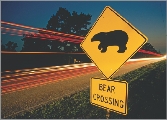Are We Helping or Harming?
The way we live our lives can affect our environment in both positive and negative ways. Sometimes our actions benefit the environment because we might help a certain plant or animal population get larger. For example, imagine that you plant tulips in your neighborhood. This action helps the tulip population grow in your area. Suppose you put seeds out for the birds in your area. Then, the bird population might get larger, too.
On the other hand, our activities can also harm plant and animal populations. Think about all of the plants and animals in neighborhood parks. What happens to the population of these plants and animals if the parks turn into apartment buildings? These plants and animals might die or move someplace else because of increased development. As a result, the area’s plant and animal population decreases.
Over-hunting, pollution, and other activities can also decrease the population of a species. The population may become so small that it is in danger of dying out. When a species is in danger of dying out, it is called an endangered species.

Florida’s black bears need more protection as development moves in.

An easy way to remember the threats facing plants and animals today is HIPPO. It stands for:
• Habitat loss—cutting down trees, tearing up the land; such activities often leave plants and animals with no place to live
• Introduced species—bringing in new life-forms that crowd out or feed on the ones that were there
• Pollution—chemicals and wastes that damage or even kill living things
• Population growth—more and more people who need more food and more land
• Over-consumption—hunting and fishing and harvesting too many plants or animals